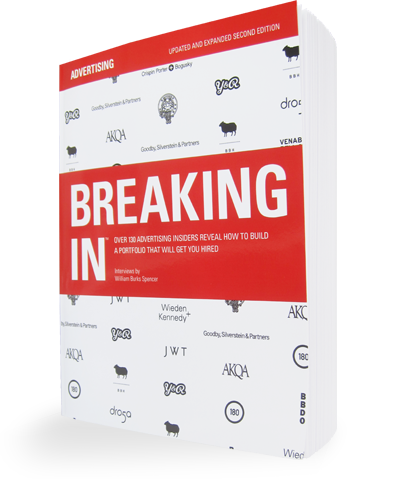Check out some great work from Kevin Russell.
Interviewed at AKQA London.
WS:What are common mistakes you see that could be avoided?
KR: …It’s the formulaic, “Here’s the three print posters with picture, headline, logo, or strapline, logo.” Very conventional. But one of the problems we’re working with the D&AD to try and rectify is the fact that things have moved along over the last, 10, 15 years in advertising. It’s not just about filling boxes. It’s not just about communicating to consumers. It’s about engaging them, and getting a two-way dialogue. And keep that going for three months with a limited budget, and get them involved in something. And some of the tutors don’t have an idea of how that works. Some have come from 1970s advertising school. What we like, and what I like to see, is a bit more of a fresh perspective on integrated stuff. The students should be the next generation of creators, and for them to come in with something that looks like [something that’s been done in the past is not good]. In terms of agencies, look at Goodby and Crispin Porter. You’ve got these fully integrated ideas, and it doesn’t necessarily have to be, “Here’s your TV ad, and here’s your this and that.” It’s like the “fast” for the [Volkswagen] Golf. It’s an actual toy that [Crispin Porter + Bogusky] built to create desirability. So fresh ideas that totally buck the trend and just go against the grain. That’s what I look for…
WS:Do people bring in sketches of print ads? Or do they bring in things that are comped up on a computer? Or websites? What do you prefer to see?
KR: As long as the ideas shine through, we’re really not pushed. A little bit of effort does go a long way. But a very badly drawn scamp makes it look like they couldn’t be bothered, or they’ve just knocked it out that morning. And sometimes they have.
[ … ]
It really goes a long way as well, to show that they’ve got Photoshop skills; they’ve got a passion for design and layout. If you can clearly see, “Right. That person’s going to go in an art direction.” Because the creative teams these days are all saying, “Oh, well we do a bit of both” [art direction and copywriting]. Sometimes it gets to that point where it’s like, “Well, we need to hand it off to someone.” And they’ve only done, maybe, 40 percent of the job.
WS:Do you have any advice for someone who wants to get into, or is interested in, a digital agency, but they’re coming from a traditional agency or traditional portfolio school?
KR: Definitely. Do veer away from, and spend two projects at least trying to veer away from, the “three-print, one 30-second script” execution of a campaign. Because I think traditional agencies, even now, are starting to think, “Well, we need to start getting like Crispin,” and becoming a bit more integrated and a bit more off the wall with our thinking in terms of format.
So, do attempt digital. You want to display your thinking through digital in some way. It still could be a scamp and stuff—-you don’t need to work up a website—-and do some coding, or anything like that. They hire the experts to do that for you. It’s just about this engagement. It’s a very simple principle. And the very simple difference between the two is one is push messaging-—TV, cinema, press-—where you have a captive audience and you’re pushing it out, not expecting any response. You can’t measure it. With digital, you are expecting a response. You’re expecting them to come further into your website. Go ’round, watch this film, send it on to a friend, do that. Enter your email address. And it’s very much an active relationship. And you’re asking a hell of a lot of the person. So that’s the thing we need to see. Can your thinking engage someone to that level where they spend seven minutes with this brand, and leave their email address, etc., etc.? So there’s a lot more to ask…

Comments are closed.